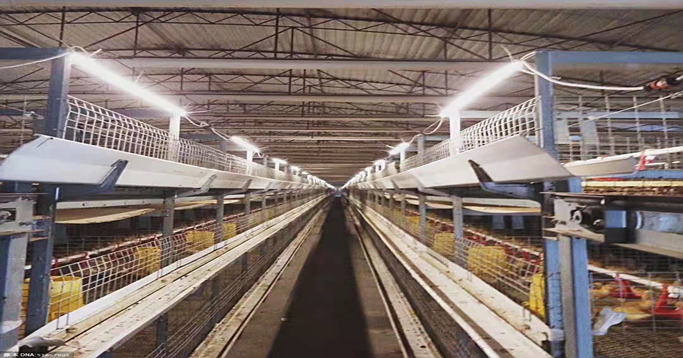Farming factory lightingapplication-waterproof tube
The cold light source ofthe LED waterproof light tube controls the lighting of the chicken house, andwith the heat dissipation system, the mood of the laying hens will be morestable and easier to raise. Among them, red light can stimulate egg production,green light can increase egg size, and a single light source can increase thesurvival rate of young hens. So in theory, the laying hens will lay more eggs,and the taste of the eggs will be better.
The use of LED lightsfor breeding in chicken farms is certainly a new thing and a new idea. However,we should first know how to use LED waterproof tubes in chicken farms. There isa lot of knowledge in this, and this article will discuss it for everyone.

It should be understood thatthe poultry farming industry is usually very conservative, and it must take awhile before it can accept LED technology. However, now the poultry farmingindustry has completely embraced LED technology and its energy-saving benefits.In the past few years, increasingly sophisticated LED technology has graduallymet the lighting needs of the poultry farming industry.
A good LED waterprooftube can save 80% to 85% energy than an incandescent lamp. But not all LEDlights are the same. Practitioners in the aquaculture industry should spendtime researching LED lights before buying. All LED lamps are more expensivethan incandescent lamps, so you definitely don't want to make mistakes andwaste silver.
Lighting is an importantenvironmental factor in the poultry farming industry. Lighting affectsproduction efficiency, animal welfare, and growth rate. The four major elementsof light are intensity, period, source and spectral range. The color of lightdepends on the different wavelengths in the visible spectrum.
White light includes allwavelengths in the visible spectrum. But even the same white light will showdifferent color temperatures due to the different energy emitted by differentwavelengths. Therefore, poultry farmers should not try to use LED bulbs lightlywithout asking for details or consulting trusted sources.
LED field test
Fortunately, manywell-known universities in the United States, including Mississippi StateUniversity, Auburn University, University of Georgia, University of Arkansas,University of Maryland, University of Delaware, etc., when LED first enteredthe poultry industry The test. After numerous field tests, these promoters haveevaluated a variety of different LED products and provided fair evaluationresults on the cost analysis, investment recovery potential and service life ofthe products. These evaluation results are provided free of charge, so pleasefeel free to request and study carefully to help you make the right purchasedecision.
Please do not choose LEDbulbs that have not been field-proven in the chicken house. Due to theinfluence of dust, humidity and ammonia, the environment of chicken coops ismuch harsher than that of houses and businesses. Some bulbs are not designedfor such an environment, nor can they stand the test of these factors.
The energy-savingperformance of LED is impeccable. The question farmers have about LEDs is, willpoultry perform as well under LED lights as they do under incandescent lights?
The answer is yes, butit needs to be under conditions where there is sufficient light during thehatching and growth period, the dimmer is working properly, and the poultry iswell taken care of. In this way, the performance of poultry under the LED lightwill be as good as under any other light source.
What effect does LEDhave on poultry?
Many farmers haveswitched from compact fluorescent lights to LED lights and found that thetemperament of the poultry has become more docile. This may be because LEDlights do not flicker like fluorescent lights. Because chickens have sharpereyesight than humans, chickens are more susceptible to flashing lights.
To some extent, LEDtechnology is ahead of dimmer technology, so not all dimmers can be adapted toLED bulbs. As a result, the LED bulb cannot be dimmed in a linear manner likean incandescent lamp (the so-called linear means that when the dimmer is dimmedby 20%, the brightness of the bulb is also dimmed by 20%). On LED lights, thedimmer may need to be adjusted very greatly to make the LED lights show alittle darkening. Dimmer manufacturers are also struggling to catch up, butthere are still many old dimmers on the market that need to be upgraded toaccurately adjust the brightness of the LED lights.
Some dimmers may onlyneed to install an upgrade chip to work normally, but some dimmers are too oldand can only be replaced with newer products to adapt to more advanced LEDtechnology.
Choose LED bulbs withappropriate color temperature. The color temperature is expressed in Kelvintemperature units (Kelvin). The warm light is from 2700 to 3000, similar toincandescent light or high-pressure sodium light, with orange-red color.Natural light ranges from 3400 to 3700 Kelvin. The cold light has abluish-white color, ranging from 5000 to 6000 Kelvin.
At present, the colortemperature of the most widely used LED light in broiler chicken breeding is5000 Kelvin, while the most widely used in breeder chicken breeding is 2700.Again, not all LED lights are suitable for breeding. A high-quality householdomnidirectional LED light is not the best choice for chicken coops.
About 40% of theomnidirectional LED waterproof tubes can illuminate the roof and walls, whichmay be good for houses, but not practical for chicken coops, because chickencoops require most of the lights to shine directly on the ground.
For this reason, it maybe necessary to purchase high-wattage LED lights to meet the needs of chickens.These lights are more expensive than low-wattage LED lights. Most of the LEDlights sold in hardware stores or discount stores are omnidirectional lights.
Even the cheapest LEDlamps are more expensive than incandescent lamps, so please make sure that theLED lamps you buy are what you need. You need to understand the unit ofluminous flux and the meaning of luminous flux readings in use. Yourafter-sales technician may bring an illuminance meter to the chicken house tomeasure the lighting effects on the spot.
Foot-candle is a unit oflight intensity, which can measure the light intensity of different lightsources. One footcandle is equal to one lumen falling on an area of one square foot. 1 lumens is equal to the totalemitted luminous flux produced by 1 candle at a solid angle, which reflects thebrightness. For example, a 10W 19A non-dimmable LED bulb may have a brightnessof 900 lumens; a 6W 19A dimmable LED bulb may have a brightness of 530 lumens.
Chicks usually require 2foot candles or more during 4-14 days of birth, depending on the breed andnutritional plan. However, the light must be adjusted to a very dark level (0.03foot candles or lower) in the subsequent period to keep the chickens in goodgrowth condition. Proper light intensity is the key to maintaining poultrycondition. The light should be much higher than the feeding trough and try notto illuminate the wall. Even lighting of the chicken house is very important,and there should not be too dark or too bright areas.
LED manufacturers areconstantly improving their processes to avoid dark spots and reduce the rangeof excessive brightness. Accurate lighting angles can help direct light topoultry and reduce wasted light on walls and ceilings.
How does LED perform inthe farm?
Most LED lights are usedfor broiler chickens, and there are recent attempts to apply them to young hensand broiler breeders. Early results show that the effect of the latter twochickens is as good as that of broilers.
A broiler broiler farmin Mississippi replaced all high-pressure sodium lamps in its four chickencoops with LED lamps a year ago. This move saves $1,500 in monthly electricitybills. The production indicators of chickens under LED lights are no differentfrom those under high pressure sodium lights. This farm uses 10 watts 2700 open19A non-dimmable LED light bulbs. Two light strips each 10 feet long areinstalled above the chicken coop, and two light strips are installed above theslit in the middle of the chicken coop. Once again, young hen and breederbreeders tend to use LED lights of 2700 kw, while broiler breeders tend to useLED lights of 5000 kw.
However, a recent studyby the U.S. Department of Agriculture indicated that the weight of broilerchickens has increased under three different LED light sources (one brand of2700-on light bulbs and the other two brands of 5000-on light bulbs). Comparedwith the broilers, there is no difference in blood physiological indicators.This may indicate that these three types of LED light sources can replaceincandescent lamps in commercial poultry farming, reducing energy consumptionand improving production efficiency without affecting physiological indicators.
In the United States andCanada, the federal government’s environmental quality incentive program andthe local government’s conservation program encourage producers to replaceincandescent lamps with energy-saving LED lamps. If possible, these projectscan be used to get corresponding incentives.
But in many cases, thewaiting list is very long. Once you sign up, you need to wait a long timebefore you can get your turn. A farm energy audit report may be required toqualify for the conservation plan, which can be an additional expense. As aresult, more and more farmers choose to replace the light bulbs themselves andsave electricity immediately instead of waiting for subsidies from the savingplan.
In the long run, even ifyou don't join the saving plan, it is a wise choice to buy bulbs yourself andreplace LED lights. Within one year, the electricity bills saved by the LEDlights can offset the purchase expenses. And most LED lights have a warrantyperiod of at least three years, and some brands also provide a warranty periodof up to five years.
Finally, I repeat,please do your research and shop around before buying. Regardless of high orlow, all LED lights will save a lot of electricity bills. Choose LED lightsthat have field experience in agricultural environments (such as chickenhouses).
This article has been authenticated by the original"original", and the author has enriched Xianwen. Visit yuanben.io toquery [57CRP17S] for authorization information
It may not be used in any way, including but not limited toreprinting, extracting, copying, or creating mirror images. Offenders must beinvestigated.
The entry is created, edited and maintained by Guangdong ZhengfaTechnology. If you find that the content of the entry is suspected ofinfringement, please contact us via E-mail: gm@cn-led.net, and we will dealwith it in a timely manner in accordance with relevant laws and regulations.Without permission, commercial websites, etc. are prohibited from copying andgrabbing the contents of Toutiao Encyclopedia; reasonable users, copyrightcooperation E-mail: gm@cn-led.net, please indicate the source fromwww.cn-led.net. Feedback 2020 cn-led.net
Hot tags: shopping mall lighting,shopping mall lighting, large shopping mall lighting design, shopping mall LEDinstallation, decorative lights, ambient light manufacturers, local fashionlighting manufacturers, cabinet lights, led smart fashion lighting, led lightmanufacturers, led decorative lighting manufacturers, T5 tubes , T8 tubes, LEDlights\lights, showcase lights, magnetic rail lights, linear lights, ledlights, lighting, etc., to provide customers with a full range of lightingsolutions and professional services. Involving outdoor lighting, officelighting, industrial lighting, hotel lighting, smart lighting, campus lighting,airport lighting, brand store lighting, subway lighting, home lighting, greenlighting, landscape lighting, brand store lighting, rail transit lighting
 English
English china
china German
German Spanish
Spanish French
French Italian
Italian Portuguese
Portuguese Japanese
Japanese Korean
Korean Arabic
Arabic Russian
Russian
 Mobile Site
Mobile Site
 +86-0769-81305858
+86-0769-81305858